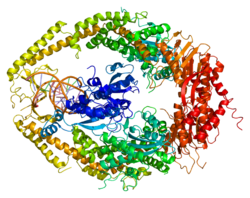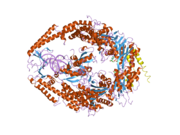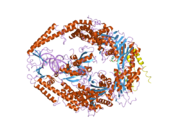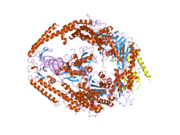- MSH2
-
MSH2 is a gene commonly associated with Hereditary nonpolyposis colorectal cancer.
MSH2 was identified as a locus frequently mutated in hereditary nonpolyposis colon cancer (HNPCC). When cloned, it was discovered to be a human homolog of the E. coli mismatch repair gene mutS, consistent with the characteristic alterations in microsatellite sequences (RER+ phenotype) found in HNPCC.[1] It is also associated with some endometrial cancers.
Contents
Interactions
MSH2 has been shown to interact with Exonuclease 1,[2][3][4] MSH3,[5][6][7][8] MSH6,[9][5][6][7][8] CHEK2,[10][11] MAX,[12] Ataxia telangiectasia and Rad3 related[5] and BRCA1.[13][9]
References
- ^ "Entrez Gene: MSH2 mutS homolog 2, colon cancer, nonpolyposis type 1 (E. coli)". http://www.ncbi.nlm.nih.gov/sites/entrez?Db=gene&Cmd=ShowDetailView&TermToSearch=4436.
- ^ Rasmussen, L J; Rasmussen M, Lee B, Rasmussen A K, Wilson D M, Nielsen F C, Bisgaard H C (Jun. 2000). "Identification of factors interacting with hMSH2 in the fetal liver utilizing the yeast two-hybrid system. In vivo interaction through the C-terminal domains of hEXO1 and hMSH2 and comparative expression analysis". Mutat. Res. (NETHERLANDS) 460 (1): 41–52. doi:10.1016/S0921-8777(00)00012-4. ISSN 0027-5107. PMID 10856833.
- ^ Schmutte, C; Marinescu R C, Sadoff M M, Guerrette S, Overhauser J, Fishel R (Oct. 1998). "Human exonuclease I interacts with the mismatch repair protein hMSH2". Cancer Res. (UNITED STATES) 58 (20): 4537–42. ISSN 0008-5472. PMID 9788596.
- ^ Schmutte, C; Sadoff M M, Shim K S, Acharya S, Fishel R (Aug. 2001). "The interaction of DNA mismatch repair proteins with human exonuclease I". J. Biol. Chem. (United States) 276 (35): 33011–8. doi:10.1074/jbc.M102670200. ISSN 0021-9258. PMID 11427529.
- ^ a b c Wang, Yi; Qin Jun (Dec. 2003). "MSH2 and ATR form a signaling module and regulate two branches of the damage response to DNA methylation". Proc. Natl. Acad. Sci. U.S.A. (United States) 100 (26): 15387–92. doi:10.1073/pnas.2536810100. ISSN 0027-8424. PMC 307577. PMID 14657349. http://www.pubmedcentral.nih.gov/articlerender.fcgi?tool=pmcentrez&artid=307577.
- ^ a b Guerrette, S; Wilson T, Gradia S, Fishel R (Nov. 1998). "Interactions of human hMSH2 with hMSH3 and hMSH2 with hMSH6: examination of mutations found in hereditary nonpolyposis colorectal cancer". Mol. Cell. Biol. (UNITED STATES) 18 (11): 6616–23. ISSN 0270-7306. PMC 109246. PMID 9774676. http://www.pubmedcentral.nih.gov/articlerender.fcgi?tool=pmcentrez&artid=109246.
- ^ a b Bocker, T; Barusevicius A, Snowden T, Rasio D, Guerrette S, Robbins D, Schmidt C, Burczak J, Croce C M, Copeland T, Kovatich A J, Fishel R (Feb. 1999). "hMSH5: a human MutS homologue that forms a novel heterodimer with hMSH4 and is expressed during spermatogenesis". Cancer Res. (UNITED STATES) 59 (4): 816–22. ISSN 0008-5472. PMID 10029069.
- ^ a b Acharya, S; Wilson T, Gradia S, Kane M F, Guerrette S, Marsischky G T, Kolodner R, Fishel R (Nov. 1996). "hMSH2 forms specific mispair-binding complexes with hMSH3 and hMSH6". Proc. Natl. Acad. Sci. U.S.A. (UNITED STATES) 93 (24): 13629–34. doi:10.1073/pnas.93.24.13629. ISSN 0027-8424. PMC 19374. PMID 8942985. http://www.pubmedcentral.nih.gov/articlerender.fcgi?tool=pmcentrez&artid=19374.
- ^ a b Wang, Y; Cortez D, Yazdi P, Neff N, Elledge S J, Qin J (Apr. 2000). "BASC, a super complex of BRCA1-associated proteins involved in the recognition and repair of aberrant DNA structures". Genes Dev. (UNITED STATES) 14 (8): 927–39. ISSN 0890-9369. PMC 316544. PMID 10783165. http://www.pubmedcentral.nih.gov/articlerender.fcgi?tool=pmcentrez&artid=316544.
- ^ Adamson, Aaron W; Beardsley Dillon I, Kim Wan-Ju, Gao Yajuan, Baskaran R, Brown Kevin D (Mar. 2005). "Methylator-induced, mismatch repair-dependent G2 arrest is activated through Chk1 and Chk2". Mol. Biol. Cell (United States) 16 (3): 1513–26. doi:10.1091/mbc.E04-02-0089. ISSN 1059-1524. PMC 551512. PMID 15647386. http://www.pubmedcentral.nih.gov/articlerender.fcgi?tool=pmcentrez&artid=551512.
- ^ Brown, Kevin D; Rathi Abhilasha, Kamath Ravindra, Beardsley Dillon I, Zhan Qimin, Mannino Jennifer L, Baskaran R (Jan. 2003). "The mismatch repair system is required for S-phase checkpoint activation". Nat. Genet. (United States) 33 (1): 80–4. doi:10.1038/ng1052. ISSN 1061-4036. PMID 12447371.
- ^ Mac Partlin, Mary; Homer Elizabeth, Robinson Helen, McCormick Carol J, Crouch Dorothy H, Durant Stephen T, Matheson Elizabeth C, Hall Andrew G, Gillespie David A F, Brown Robert (Feb. 2003). "Interactions of the DNA mismatch repair proteins MLH1 and MSH2 with c-MYC and MAX". Oncogene (England) 22 (6): 819–25. doi:10.1038/sj.onc.1206252. ISSN 0950-9232. PMID 12584560.
- ^ Wang, Q; Zhang H, Guerrette S, Chen J, Mazurek A, Wilson T, Slupianek A, Skorski T, Fishel R, Greene M I (Aug. 2001). "Adenosine nucleotide modulates the physical interaction between hMSH2 and BRCA1". Oncogene (England) 20 (34): 4640–9. doi:10.1038/sj.onc.1204625. ISSN 0950-9232. PMID 11498787.
Further reading
- Jiricny J (1994). "Colon cancer and DNA repair: have mismatches met their match?". Trends Genet. 10 (5): 164–8. doi:10.1016/0168-9525(94)90093-0. PMID 8036718.
- Fishel R, Wilson T (1997). "MutS homologs in mammalian cells.". Curr. Opin. Genet. Dev. 7 (1): 105–13. doi:10.1016/S0959-437X(97)80117-7. PMID 9024626.
- Lothe RA (1997). "Microsatellite instability in human solid tumors.". Molecular medicine today 3 (2): 61–8. doi:10.1016/S1357-4310(96)10055-1. PMID 9060003.
- Peltomäki P, de la Chapelle A (1997). "Mutations predisposing to hereditary nonpolyposis colorectal cancer.". Adv. Cancer Res. 71: 93–119. doi:10.1016/S0065-230X(08)60097-4. PMID 9111864.
- Papadopoulos N, Lindblom A (1997). "Molecular basis of HNPCC: mutations of MMR genes.". Hum. Mutat. 10 (2): 89–99. doi:10.1002/(SICI)1098-1004(1997)10:2<89::AID-HUMU1>3.0.CO;2-H. PMID 9259192.
- Kauh J, Umbreit J (2004). "Colorectal cancer prevention.". Current problems in cancer 28 (5): 240–64. doi:10.1016/j.currproblcancer.2004.05.004. PMID 15375803.
- Warusavitarne J, Schnitzler M (2007). "The role of chemotherapy in microsatellite unstable (MSI-H) colorectal cancer.". International journal of colorectal disease 22 (7): 739–48. doi:10.1007/s00384-006-0228-0. PMID 17109103.
- Wei Q, Xu X, Cheng L, et al. (1995). "Simultaneous amplification of four DNA repair genes and beta-actin in human lymphocytes by multiplex reverse transcriptase-PCR.". Cancer Res. 55 (21): 5025–9. PMID 7585546.
- Wilson TM, Ewel A, Duguid JR, et al. (1995). "Differential cellular expression of the human MSH2 repair enzyme in small and large intestine.". Cancer Res. 55 (22): 5146–50. PMID 7585562.
- Drummond JT, Li GM, Longley MJ, Modrich P (1995). "Isolation of an hMSH2-p160 heterodimer that restores DNA mismatch repair to tumor cells.". Science 268 (5219): 1909–12. doi:10.1126/science.7604264. PMID 7604264.
- Kolodner RD, Hall NR, Lipford J, et al. (1995). "Structure of the human MSH2 locus and analysis of two Muir-Torre kindreds for msh2 mutations.". Genomics 24 (3): 516–26. doi:10.1006/geno.1994.1661. PMID 7713503.
- Wijnen J, Vasen H, Khan PM, et al. (1995). "Seven new mutations in hMSH2, an HNPCC gene, identified by denaturing gradient-gel electrophoresis.". Am. J. Hum. Genet. 56 (5): 1060–6. PMC 1801472. PMID 7726159. http://www.pubmedcentral.nih.gov/articlerender.fcgi?tool=pmcentrez&artid=1801472.
- Mary JL, Bishop T, Kolodner R, et al. (1995). "Mutational analysis of the hMSH2 gene reveals a three base pair deletion in a family predisposed to colorectal cancer development.". Hum. Mol. Genet. 3 (11): 2067–9. PMID 7874129.
- Fishel R, Ewel A, Lescoe MK (1994). "Purified human MSH2 protein binds to DNA containing mismatched nucleotides.". Cancer Res. 54 (21): 5539–42. PMID 7923193.
- Fishel R, Ewel A, Lee S, et al. (1994). "Binding of mismatched microsatellite DNA sequences by the human MSH2 protein.". Science 266 (5189): 1403–5. doi:10.1126/science.7973733. PMID 7973733.
- Liu B, Parsons RE, Hamilton SR, et al. (1994). "hMSH2 mutations in hereditary nonpolyposis colorectal cancer kindreds.". Cancer Res. 54 (17): 4590–4. PMID 8062247.
- Maruyama K, Sugano S (1994). "Oligo-capping: a simple method to replace the cap structure of eukaryotic mRNAs with oligoribonucleotides.". Gene 138 (1-2): 171–4. doi:10.1016/0378-1119(94)90802-8. PMID 8125298.
- Fishel R, Lescoe MK, Rao MR, et al. (1994). "The human mutator gene homolog MSH2 and its association with hereditary nonpolyposis colon cancer.". Cell 77 (1): 167. doi:10.1016/0092-8674(94)90306-9. PMID 8156592.
- Fishel R, Lescoe MK, Rao MR, et al. (1994). "The human mutator gene homolog MSH2 and its association with hereditary nonpolyposis colon cancer.". Cell 75 (5): 1027–38. doi:10.1016/0092-8674(93)90546-3. PMID 8252616.
PDB gallery 2o8b: human MutSalpha (MSH2/MSH6) bound to ADP and a G T mispair2o8c: human MutSalpha (MSH2/MSH6) bound to ADP and an O6-methyl-guanine T mispair2o8d: human MutSalpha (MSH2/MSH6) bound to ADP and a G dU mispair2o8e: human MutSalpha (MSH2/MSH6) bound to a G T mispair, with ADP bound to MSH2 only2o8f: human MutSalpha (MSH2/MSH6) bound to DNA with a single base T insertSee also
- Mismatch_repair#MutS
External links
Excision repair Other forms of repair Other/ungrouped proteins Regulation Other/ungrouped 8-Oxoguanine • Adaptive response • Meiotic recombination checkpoint • RecF pathway
DNA helicase: BLM · WRN
FANC proteins: core protein complex (FANCA, FANCB, FANCC, FANCE, FANCF, FANCG, FANCL, FANCM), FANCD1, FANCD2, FANCI, FANCJ, FANCNsee also DNA repair-deficiency disorder
B bsyn: dna (repl, cycl, reco, repr) · tscr (fact, tcrg, nucl, rnat, rept, ptts) · tltn (risu, pttl, nexn) · dnab, rnab/runp · stru (domn, 1°, 2°, 3°, 4°)Categories:- Human proteins
- Biochemistry stubs
Wikimedia Foundation. 2010.







